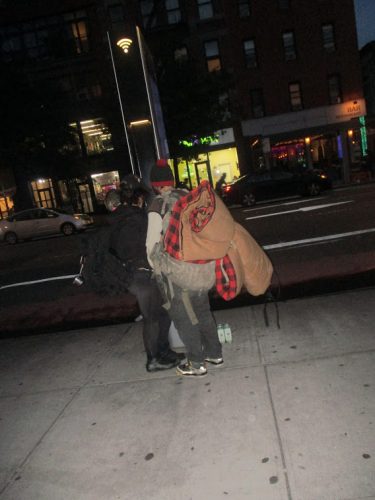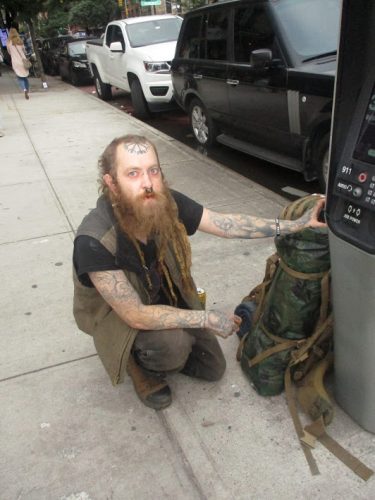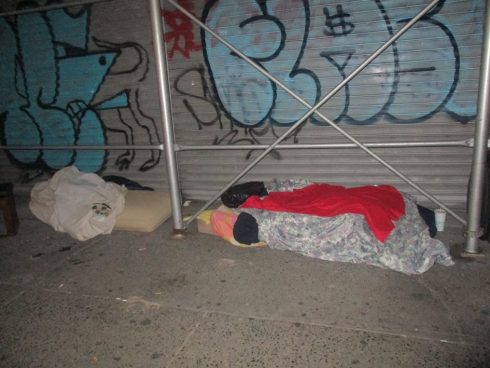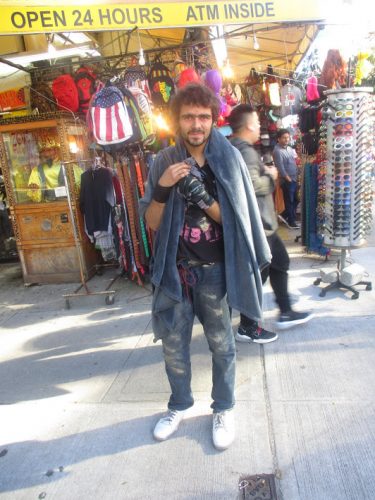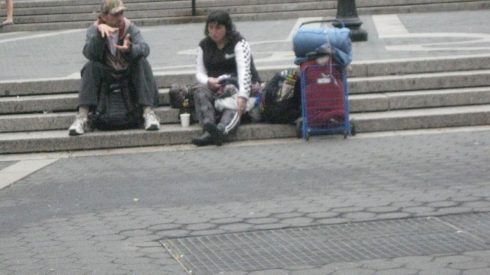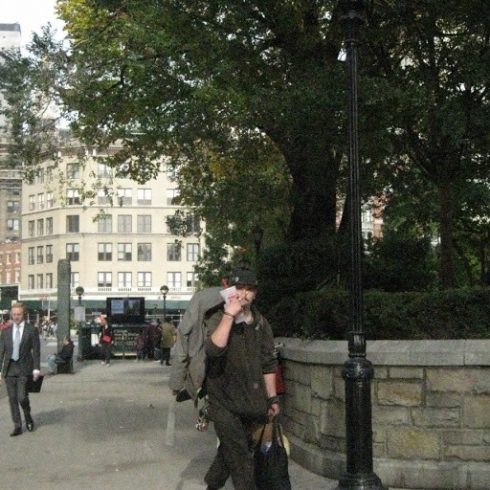A Crusty Problem about Voluntary Homeless
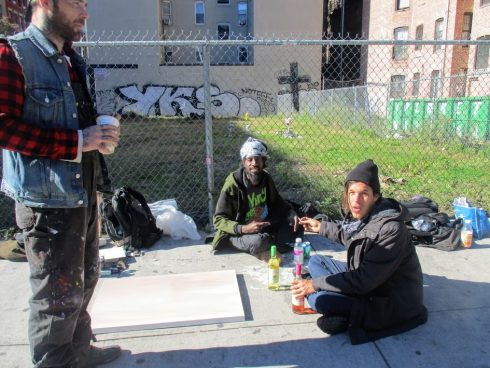
Crusties aka travelers outside their Second Avenue “home” in East Village where three buildings fell during a deadly 2015 gas explosion. All photos are by Mary Reinholz.
By Mary Reinholz
A catastrophic illness or job loss can render ordinary citizens homeless in Donald Trump’s supposedly more prosperous America. These U.S. citizens in need of food and shelter have become multitudes.
In 2018, millions of them– many impoverished, others deranged – flooded urban centers like my native Los Angeles County where homelessness increased by 23 percent last year. Homeless amount to almost 65,000 in my adopted New York City, among them an estimated 23,000 children. Single people and couples who do not stay in the city’s homeless shelters often seem to overwhelm the streets and parks of downtown Manhattan, where a few sleep in cardboard boxes around the corner of my eastside block of brownstones near Union Square.
Some begging for cash on the sidewalks are veterans of the wars in Iraq and Afghanistan. Others are employed men and women who lack sufficient income to pay rent for permanent housing.
Then there are young anti-capitalist anarchists and panhandlers who voluntarily choose to be homeless, kids in their teens and 20s with cell phones, tattoos, musical instruments and pets, the latter often fearsome looking pit bulls who have been known to bite passersby when they engage with their owners. These homeless call themselves crusties–or crust punks, in part because they’re dirty from living on sidewalks or in abandoned buildings. The name crusty may derive from the “crust” of filth that allegedly can cover their bodies.
Most crusties (or travelers as some prefer to be called) I’ve encountered recently are male but they have female friends too. One of those women used to be award winning film director Martine Blue who now lives in Newfoundland. She was 24 when she fell in love with a so-called gutter punk in the East Village, and left her comfortable existence to become a crusty with him. She recalls drinking, dumpster diving, hopping freight trains, “pissing into bottles and shitting in bags,” engaging in three way sex and traveling the world with her dog. Her experience became the basis for a fictional film, “Hunting Pignut,” which opened for general release last year in Canada, according to the Vice Canada blog. Blue reports that many of her crusty pals she met along the way are dead after vagabonding around the country, presumably high on drugs. Their numbers in the U.S. are inexact but many are said to live in the Pacific Northwest.
“There are thousands of us all over the country!” claimed a professed crusty who identified himself as LeRoy Jenkins, age 30, as he sat near a cell phone charging kiosk on Second Avenue near 8th Street in the East Village. The latter block is St. Mark’s Place, once nexus and plexus of flower power during the 1960s and 70s hippie counter culture. Jenkins was clean with a carefully clipped beard and smoked a cigarette from he a pack he bought on discount at an Indian reservation in Suffolk County, boasting he got weed there as well.
The dark-haired and wiry Jenkins spoke loudly and clearly, claiming he worked as a building contractor and was now living mostly in Long Island with his middle class parents after having reconciled with them after years on the road. “I work!” he shouted defensively. “I come here on weekends to be with my (alternate) family!”
Informed that some locals are afraid of crusties, Jenkins retorted angrily that he and his comrades “don’t give a fuck” about what other people think of them.
Asked why he was so upset, a female fellow traveler named Kaitlin, 24, an aspiring fiddler from Nashville, Tenn., who was panhandling with a small sign (“Anything helps”) and sitting on the pavement with a plate of coins, said softly, “Some people don’t even think we’re human.”
Indeed, a long time Second Avenue resident who attended a fall meeting of the New York Police Department’s Ninth Precinct Community Council called the crusties on his block “animals” several times during interviews with this reporter, claiming they insulted and “cursed” him out daily and terrified his wife and daughter. He asked to be identified as Stephen Lipski, an assumed name.
Lipski, a 64-year-old retired high school science teacher living in a rent stabilized apartment, told Captain John O’Connell, the precinct’s commanding officer: “I see their hypodermic needles. I see their (hidden) bottles. I see them defecating between cars on E. 7th Street,” he said, then pleaded to the top cop: “Put in overhead lights!”He told me the strong NYPD light beaming down on the crusty hangout would scare the rascals away at night.
O’Connell, new to his post in the East Village, soon installed an NYPD flood light at the location, site of a deadly 2015 gas explosion that leveled three buildings. But a few days before, one of the crusties, a goateed 25-year-old named Zeke, grabbed a reporter from the New York Post in a chokehold and punched him in the head after objecting about the use of his name in an article to be written for the daily tabloid.
The reporter, Dean Balsamini, did not file charges and there were no arrests. It’s not illegal to be homeless in New York. But the Ninth precinct cops cracked down on the crusties who had regularly gathered in front of the fenced vacant lot throughout the summer and into the autumn days before Halloween, asking them to move on immediately. Captain O’Connell told me the crusties informed him that they considered Zeke “emotionally disturbed” and didn’t want to have anything to do with him. O’Connell also claimed the police cleanup at the Second Avenue site had been in the planning stages for weeks after a merchant complained their presence was hurting business.
As it turned out, I ran into the aforementioned Zeke a day after his “crust-up” with the Postie, not knowing it had occurred, and he seemed rational to me. All he did was ask for money, apparently not realizing I was a reporter. I asked him why he was no longer hanging out outside the lot on Second Avenue and East 7th Street. “The cops told us to leave,” he said, his voice becoming a bit agitated.
Next, I asked if I could take a picture of him. He said, “Sure,” and smiled vaguely. He was a good looking muscular guy of medium size. His left hand was wrapped in black tape. Another picture of a more sinister looking guy who could pass for Zeke surfaced a week later in the email of a source. The photo showed his left hand with the words HATE scrawled in black individual letters on his four extended fingers. The images seemed ominous.
A female shop owner who had complained about the crusties at the Ninth precinct said one of them had threatened her after the police crackdown, blaming her for the loss of their “Second Avenue home”and claiming in emails that they intended to leave “piss and shit” on her door step in retaliation. She asked for anonymity for this article.
Her next door neighbor, the aforementioned Stephen Lipski, got the smelly bundle instead of her. It was placed in the hallway of his building. “These are sick individuals,” he told me in a recent phone conversation. “I told my wife and daughter not to step into it.”
Yet Lipski described the mess as rather artistically designed. “It was in the shape of the AIDS ribbon but tastefully done. And it stunk to high heaven.”
Earlier, Lipski made it clear he doesn’t think the police will do much of anything to remove the unwanted homeless visitors in the future. “They’re here by choice because rich people from Tribeca give them money. I’ve seen one perform fellatio in a car, presumably for pay,” he said. “I’ve reported them to the police and the police give me lessons on their rights. They say if they don’t see a crime, it’s not illegal.”
Lipski, who believes the crusties will eventually return to his block, considers some of them violent, noting he’s seen a “skinhead with a swastika on his chest” among them. “These homeless are made up of all types and some of them spit at you,” he said. He claimed that an African American crust punk told him, “‘If you fuck with me, I’ll kill you.'”
One crusty reportedly hit the owner of a Second Avenue hamburger joint with his broom when he asked him to leave his doorstep.
New Yorkers, of course, are fully aware of horrific incidents in which mentally ill homeless have struck out at locals, sometimes fatally, and often worry that one will creep up behind them in the subways and push them onto the tracks. This happened in Brooklyn in 2016 when a homeless man tried to shove a woman in front of an oncoming train. She was able to survive by grabbing onto a pillar and boarding the train, later reporting the man to police.
Others in the East Village don’t regard most crusty travelers as prone to violence, among them Susan Stetzer, district manager of Community board 3 which covers Second Avenue. Stetzer told me she was “not aware” of any violence from “this population” in the area. “People are allowed by law to be on the street,” she said. “If they are doing something criminal, that is not allowed. However, police need to see evidence.”
Sergeant Lesley Bailey, who heads the ninth precinct’s Neighborhood Coordination Officers, put the issue succinctly: “We can’t arrest people just because they’re hanging out.”
That’s good to know in Trump’s America. In any case, it’s getting colder and some say the crusties will gravitate to more hospitable spots, perhaps to Coney Island. Others observe they’ve simply moved a few blocks up to Union Square, where I took quite a few pictures of kids with camping gear.
Meanwhile, overall crime has declined in the rapidly gentrifying East Village. Homeless were not cited in a recent report by Captain O’Connell at a community council meeting in October: “We had only 14 crimes for the whole week–usually it’s 25 or 30. Seven were grand larcenies” like “when somebody left their wallets on a bench or in a taxi,” he said. “We had three commercial burglaries with people getting into windows. It’s pretty remarkable that we had a 15 percent decline in 28 days, so we’re going in the right direction.”
Comments
Leave a Reply
You must be logged in to post a comment.

